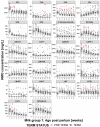Human Milk Oligosaccharides in the Milk of Mothers Delivering Term versus Preterm Infants
- PMID: 31195757
- PMCID: PMC6627155
- DOI: 10.3390/nu11061282
Human Milk Oligosaccharides in the Milk of Mothers Delivering Term versus Preterm Infants
Abstract
Human milk oligosaccharides (HMOs) are a major component of human milk, and play an important role in protecting the infant from infections. Preterm infants are particularly vulnerable, but have improved outcomes if fed with human milk. This study aimed to determine if the HMO composition of preterm milk differed from that of term milk at equivalent stage of lactation and equivalent postmenstrual age. In all, 22 HMOs were analyzed in 500 samples of milk from 25 mothers breastfeeding very preterm infants (< 32 weeks of gestational age, < 1500g of birthweight) and 28 mothers breastfeeding term infants. The concentrations of most HMOs were comparable at equivalent postpartum age. However, HMOs containing α-1,2-linked fucose were reduced in concentration in preterm milk during the first month of lactation. The concentrations of a number of sialylated oligosaccharides were also different in preterm milk, in particular 3'-sialyllactose concentrations were elevated. At equivalent postmenstrual age, the concentrations of a number of HMOs were significantly different in preterm compared to term milk. The largest differences manifest around 40 weeks of postmenstrual age, when the milk of term infants contains the highest concentrations of HMOs. The observed differences warrant further investigation in view of their potential clinical impact.
Keywords: 2′-fucosyllactose (2′FL); 3′-sialyllactose (3′SL); Lewis; disialyllacto-N-tetraose (DSLNT); human milk oligosaccharides (HMO); lactation; milk group; preterm; secretor.
Conflict of interest statement
S.A., C.A.D.C., N.S., A.B., M.A., and C.L.G.R. are all employees of Nestec Ltd. L.B., J.F.T. and C.J.F.F. declare no conflict of interest.
Figures







Similar articles
-
Longitudinal change of selected human milk oligosaccharides and association to infants' growth, an observatory, single center, longitudinal cohort study.PLoS One. 2017 Feb 9;12(2):e0171814. doi: 10.1371/journal.pone.0171814. eCollection 2017. PLoS One. 2017. PMID: 28182762 Free PMC article.
-
[Levels of human milk oligosaccharides in breast milk of mothers delivering preterm infants of different gestational ages and their effects on early growth and development].Zhonghua Yu Fang Yi Xue Za Zhi. 2021 Sep 6;55(9):1067-1076. doi: 10.3760/cma.j.cn112150-20210513-00468. Zhonghua Yu Fang Yi Xue Za Zhi. 2021. PMID: 34619923 Chinese.
-
Human Milk Oligosaccharides Are Associated with Lactation Stage and Lewis Phenotype in a Chinese Population.Nutrients. 2023 Mar 15;15(6):1408. doi: 10.3390/nu15061408. Nutrients. 2023. PMID: 36986137 Free PMC article.
-
The Mean of Milk: A Review of Human Milk Oligosaccharide Concentrations throughout Lactation.Nutrients. 2021 Aug 9;13(8):2737. doi: 10.3390/nu13082737. Nutrients. 2021. PMID: 34444897 Free PMC article. Review.
-
The Role of Maternal Secretor Status and Human Milk Oligosaccharides on Early Childhood Development: A Systematic Review and Meta-Analysis.Breastfeed Med. 2024 Jun;19(6):409-424. doi: 10.1089/bfm.2023.0274. Epub 2024 Apr 5. Breastfeed Med. 2024. PMID: 38577928
Cited by
-
Untangling human milk oligosaccharides and infant gut microbiome.iScience. 2021 Dec 1;25(1):103542. doi: 10.1016/j.isci.2021.103542. eCollection 2022 Jan 21. iScience. 2021. PMID: 34950861 Free PMC article. Review.
-
Human Milk Oligosaccharides, Growth, and Body Composition in Very Preterm Infants.Nutrients. 2024 Apr 18;16(8):1200. doi: 10.3390/nu16081200. Nutrients. 2024. PMID: 38674890 Free PMC article.
-
Modifications of Own Mothers' Milk Fortification Protocol Affect Early Plasma IGF-I and Ghrelin Levels in Preterm Infants. A Randomized Clinical Trial.Nutrients. 2019 Dec 14;11(12):3056. doi: 10.3390/nu11123056. Nutrients. 2019. PMID: 31847328 Free PMC article. Clinical Trial.
-
Dietary Fiber to Starch Ratio Affects Bovine Milk Oligosaccharide Profiles.Curr Dev Nutr. 2022 Mar 7;6(6):nzac033. doi: 10.1093/cdn/nzac033. eCollection 2022 Jun. Curr Dev Nutr. 2022. PMID: 35711571 Free PMC article.
-
Human milk oligosaccharides in milk of mothers with term and preterm delivery at different lactation stage.Carbohydr Polym. 2023 Dec 1;321:121263. doi: 10.1016/j.carbpol.2023.121263. Epub 2023 Aug 6. Carbohydr Polym. 2023. PMID: 37739493 Free PMC article.
References
-
- Fewtrell M., Bronsky J., Campoy C., Domellof M., Embleton N., Fidler Mis N., Hojsak I., Hulst J.M., Indrio F., Lapillonne A., et al. Complementary feeding: A position paper by the european society for paediatric gastroenterology, hepatology, and nutrition (espghan) committee on nutrition. J. Pediatr. Gastroenterol. Nutr. 2017;64:119–132. doi: 10.1097/MPG.0000000000001454. - DOI - PubMed
-
- Agostoni C., Buonocore G., Carnielli V.P., De Curtis M., Darmaun D., Decsi T., Domellof M., Embleton N.D., Fusch C., Genzel-Boroviczeny O., et al. Enteral nutrient supply for preterm infants: Commentary from the european society of paediatric gastroenterology, hepatology and nutrition committee on nutrition. J. Pediatr. Gastroenterol. Nutr. 2010;50:85–91. doi: 10.1097/MPG.0b013e3181adaee0. - DOI - PubMed
Publication types
MeSH terms
Substances
LinkOut - more resources
Full Text Sources
Other Literature Sources
Medical

